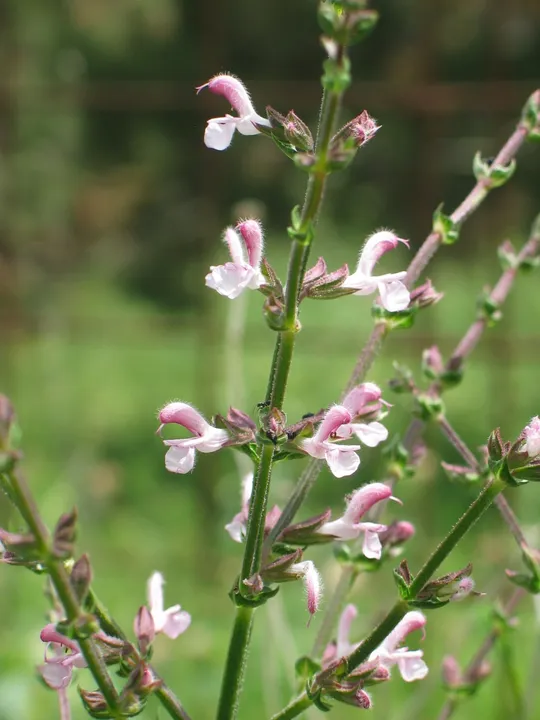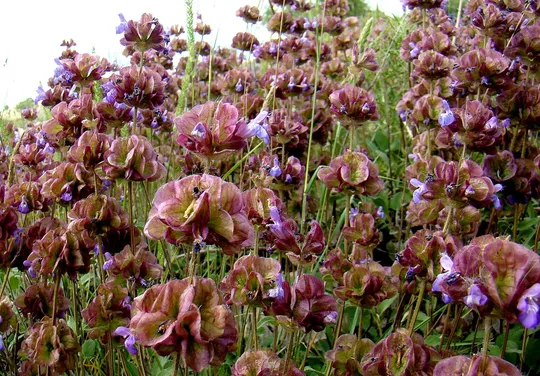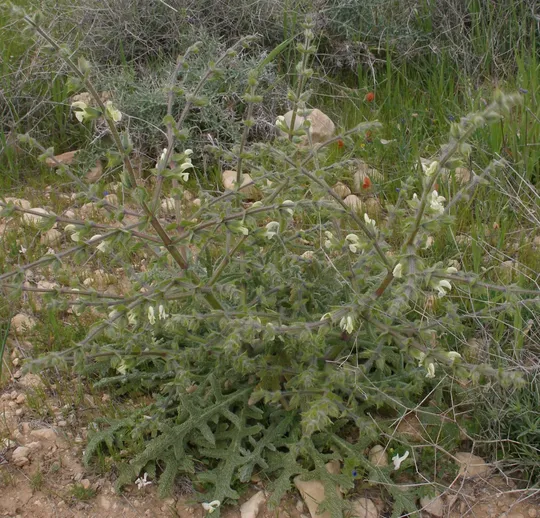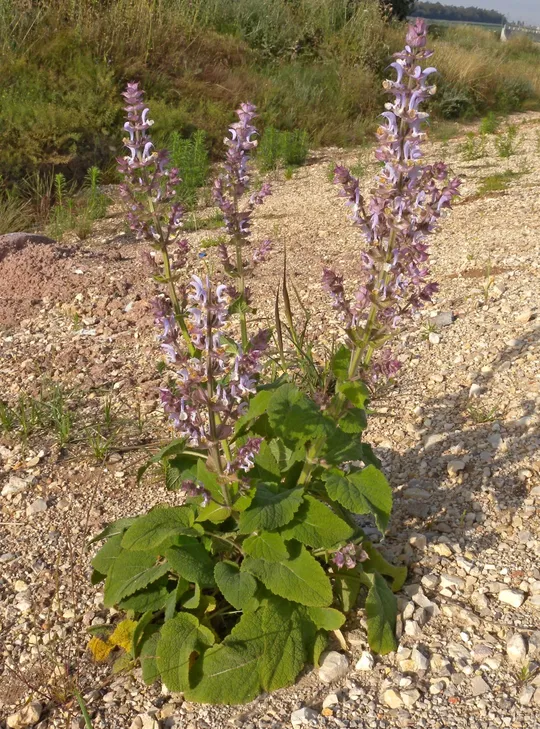Bramble-leaved Sage
Salvia rubifolia
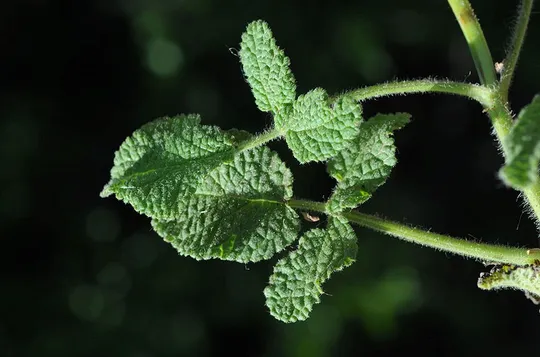
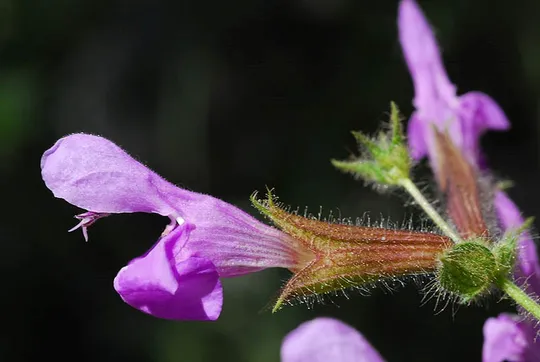
Salvia rubifolia grows in the
Judean Hills in Israel, at a single site in Wadi Ma'oz Tsion east of En Naqoba,
where Mimi Ron and Avi Shmida found a single cluster of shrubs in 2002. On the
Hermon (not in the scope of this book), it appears in the area of the Wadi
Si'on slopes of Mount Dov, and on the HaKakhal and Duvdevan ridges, particularly
in the vicinity of Wadi Ar'ar. In 2009 it was found on the Yif'at Ridge as
well.
On Mount Hermon –
in shaded habitats on rocky Jurassic dolomitic limestone, in open transition
zone Quercus boissieri forest of and woody Rosaceae species, at
altitudes of 900-1600 meters (1700 meters is unusual). It grows on steep slopes
with a rock cover above 50%, or piles of stones, between the trees in the montane
forest zone where the plant intertwines with other shrub species and stones at
the foot of the trees.
Salvia rubifolia is an endemic species, characteristic
of the humid montane forest typical of the Lebanese mountains. Until 2002, it
was known from the Mount Hermon area, where it grew in the depths of Wadi Si'on
at an altitude of 900-1600 meters. There, as in other areas north of the Hermon,
S. rubifolia has a
characteristic deep blue flower and sticky hairs. The specimen that was
discovered in Wadi Ma'oz Tsion has an intense pink flower and lacks sticky
glandular hairs. Plants with pink flower can also be found on the Hermon. It is
possible that this is a new taxon to science that has not yet been described.
The isolated condition and the aridity of the Jerusalem Mountains in comparison
to the mountains of Lebanon may induce a strong evolutionary pressure on the
local population. In similar conditions, many species become extinct, the few
that survive adapt themselves to the more arid conditions, and some become new
species endemic to the isolated area. S.
rubifolia, which was found at Wadi Ma'oz Tsion, may be an,
instructive example of the geological-historical story of the Jerusalem area in
the past fifteen thousand years since the last glacial period. At that time
many northern plants became extinct and those that survived grew in small
populations, isolated in moist niches at the foot of steep cliffs and canyons
on steep northern slopes. Many of these species were wiped out by the accelerated
development in Jerusalem in recent decades.
Within the genus
Salvia, S. rubifolia belongs
to a small group of perennial Salvia species with sticky pinnate leaves
with and broad leaflets. S. pinnata, which differs
from S. rubifolia in the swollen calyx of its flowers, belongs to this group in
Israel. S. pilifera a vicarious species
of S. rubifolia, which also has blue flowers but with white spots on the labellum,
grows in the Taurus and Amanos Mountains in southern Turkey.
Post, who wrote
the Flora of the Levant (Syria, Palestine and Sinai) at the end of the
nineteenth century, described a special variety in this taxon from the Anti-Lebanon
Mountains: S. rubifolia var. aequalifolia (Post, 1896). The lateral
leaflets of this variety are almost equal in size to the terminal leaflet whereas
in the usual variety the terminal leaflet is usually larger than the lateral leaflets.
Salvia rubifolia exists in only
one cluster of shrubs in the Jerusalem Hills, which is not protected. It may
not continue to survive there if the site is not preserved. In the Hermon, its situation
is better. There is no information regarding the threat and conservation status
of the species in Lebanon and Syria.
A nature reserve
should be declared in the area of Wadi Ma'oz Tsion, En Naqoba and the slopes of
Kibbutz Tsova, as in addition to Salvia
rubifolia,
there are concentrations of many plant species that are now rare in the Jerusalem
area: Rosa canina, Knautia integrifolia, Crepis reuteriana,
Brachypodium sylvaticum, Matricaria recutita, Pimpinella
corymbosa, Cephalanthera longifolia and Neotinea maculata.
Salvia rubifolia is endemic to the
mountains of Lebanon and to Syria’s coastal ridges.
Salvia rubifolia is an extremely rare dwarf shrub that grows on a single
site in the vicinity of Jerusalem and is found on Mount Hermon. The species is endemic
to Syria, Lebanon and Israel. In Israel, it is disjunct from the sites on Mount
Hermon, Syria and Lebanon. This may be a surviving population that became
locally adapted to more arid conditions.
Current Occupancy Map
| 1000 squre meter pixel | 5000 squre meter pixel | 10000 squre meter pixel | |
|---|---|---|---|
| number of observations | 0 | 0 | 0 |
| in total pixels | 0 | 0 | 0 |
| Family | Lamiaceae |
| Classification | On the extremely rare species list of Hermon Mt |
| Ecosystem | Mediterranean |
| Chorotype | East Mediterranean |
| Conservation Site | Wadi Ma'oz Tsion, Hermon |
| Rarity |
1
6
6
|
|---|---|
| Vulnerability |
0
3
4
|
| Attractiveness |
0
0
4
|
| Endemism |
0
0
4
|
| Red number |
1
6.3
10
|
| Peripherality | N |
| IUCN category | DD EW EX LC CR EN VU NT |
| Threat Definition according to the red book | Critically endangered |
 Based on:
Based on:
